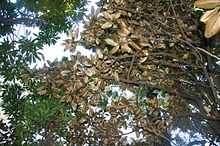Opisthiolepis
| Opisthiolepis | |
|---|---|
 | |
| O. heterophylla, leaf undersides highlighted | |
| Scientific classification | |
| Kingdom: | Plantae |
| (unranked): | Angiosperms |
| (unranked): | Eudicots |
| Order: | Proteales |
| Family: | Proteaceae |
| Subfamily: | Grevilleoideae |
| Genus: | Opisthiolepis L.S.Sm. |
| Species: | O. heterophylla |
| Binomial name | |
| Opisthiolepis heterophylla L.S.Sm.[1][2] | |
Opisthiolepis is a genus of a sole described species of large trees, constituting part of the plant family Proteaceae.[1] The species Opisthiolepis heterophylla most commonly has the names of Blush Silky Oak, Pink Silky Oak, Brown Silky Oak and Drunk Rabbit.[1][2]
These large trees to 30 m (100 ft) tall grow naturally only (endemic) in the rainforests of the wet tropics region of north eastern Queensland, Australia. While restricted to this region, within their range they occur widely in rainforests, more common in the tablelands and mountains and described as common on the Atherton Tableland.[1][2]
Taxonomy and naming
Queensland botanist Lindsay Smith named the species in 1952, from a collection from the Atherton area in the Cook District.[1][2] Material had been collected earlier by C.T. White in 1918, but lacked flowers or fruit.[3]
They are reported to share their evolutionary closest correlates with the genera Buckinghamia, Finschia, Grevillea and Hakea in the subtribe Hakeinae.[4][5][6] The genetics studies, still at an early stage, suggest Opisthiolepis may represent the continuing living lineage of the ancient branch off from near the base or from before the base of the entire present day subtribe Hakeinae.[4][6][7]
Description
Opisthiolepis heterophylla grows as a tree to 30 m (100 ft) tall with a trunk diameter of 75 cm (30 in).[3] Oval or oblong in shape,[1] the adult leaves are anywhere from 2 to 23 cm long by 2 to 9 cm wide. They have bronze undersurfaces.[2] The flower spikes, known as inflorescences, are 3 to 15 cm (1.2–6 in) long.[1]
Distribution and habitat
Found from sea level to 1150 m, Opisthiolepis heterophylla is endemic to northeastern Queensland. It generally grows on basalt soils on slopes and elevated areas,[2] in rainforest.[1]
Cultivation
Opisthiolepis heterophylla grows quickly in cultivation, one specimen in John Wrigley's garden in Coffs Harbour reaching 6 m (20 ft) high and flowering in four years.[3]
References
- ↑ 1.0 1.1 1.2 1.3 1.4 1.5 1.6 1.7 Foreman, Don B. (1995). "Opisthiolepis" (online version). In McCarthy, Patrick. Flora of Australia: Volume 16: Eleagnaceae, Proteaceae 1. Flora of Australia series. CSIRO Publishing / Australian Biological Resources Study. pp. 373–374, Figs 131, 168, Map 423. ISBN 978-0-643-05692-3.
- ↑ 2.0 2.1 2.2 2.3 2.4 2.5 Hyland, B. P. M.; Whiffin, T.; Zich, F. A. et al. (Dec 2010). "Factsheet – Opisthiolepis heterophylla". Australian Tropical Rainforest Plants. Edition 6.1, online version [RFK 6.1]. Cairns, Australia: Commonwealth Scientific and Industrial Research Organisation, through its Division of Plant Industry; the Centre for Australian National Biodiversity Research; the Australian Tropical Herbarium, James Cook University. Retrieved 4 Apr 2013.
- ↑ 3.0 3.1 3.2 Wrigley, John; Fagg, Murray (1991). Banksias, Waratahs and Grevilleas. Sydney: Angus & Robertson. pp. 465–66. ISBN 0-207-17277-3.
- ↑ 4.0 4.1 Weston, Peter H.; Barker, Nigel P. (2006). "A new suprageneric classification of the Proteaceae, with an annotated checklist of genera". Telopea 11 (3): 314–344. Retrieved 4 Apr 2013.
- ↑ Sauquet, Hervé; Weston, Peter H. et al. (6 Jan 2009). "Contrasted patterns of hyperdiversification in Mediterranean hotspots". Proceedings of the National Academy of Sciences 106 (1): 221–225. doi:10.1073/pnas.0805607106. ISSN 0027-8424. Retrieved 4 Apr 2013.
- ↑ 6.0 6.1 Mast, Austin R.; Milton, Ethan F. et al. (1 Mar 2012). "Time-calibrated phylogeny of the woody Australian genus Hakea (Proteaceae) supports multiple origins of insect-pollination among bird-pollinated ancestors". American Journal of Botany 99 (3): 472–487. doi:10.3732/ajb.1100420. PMID 22378833. Retrieved 4 Apr 2013.
- ↑ Duchene, David; Bromham, Lindell (13 Mar 2013). "Rates of molecular evolution and diversification in plants: chloroplast substitution rates correlate with species-richness in the Proteaceae". BMC Evolutionary Biology 13: 65. doi:10.1186/1471-2148-13-65. ISSN 1471-2148. Retrieved 4 Apr 2013.